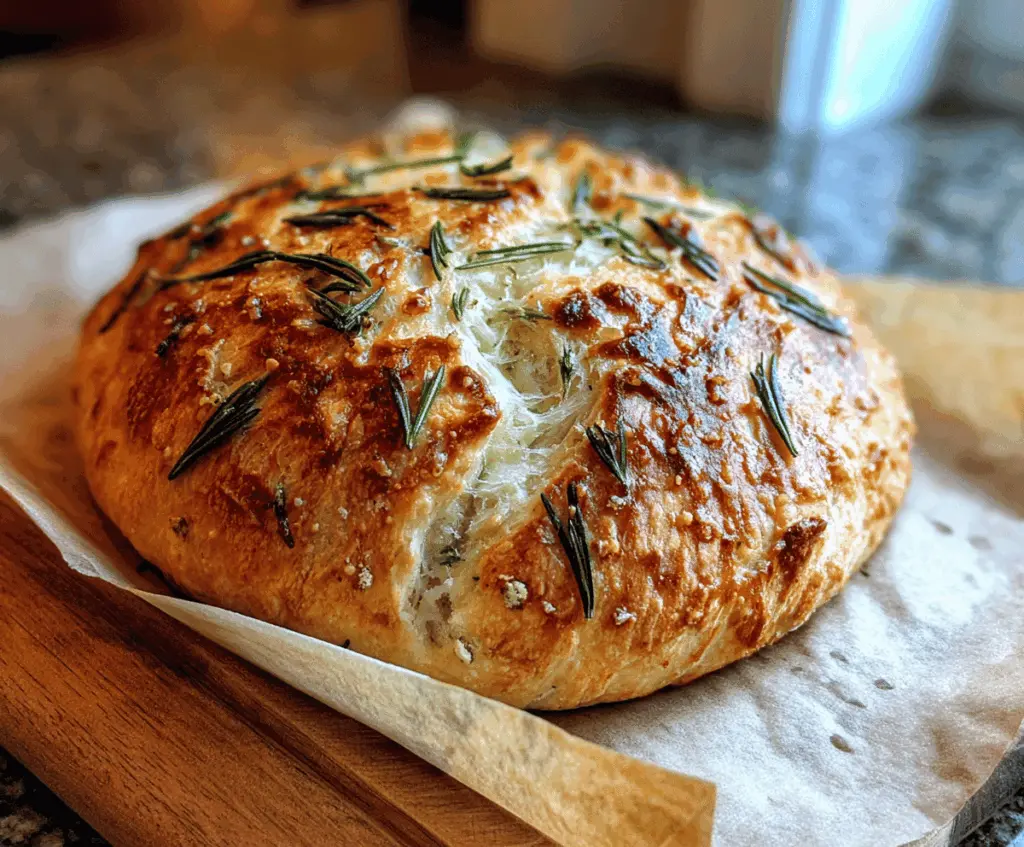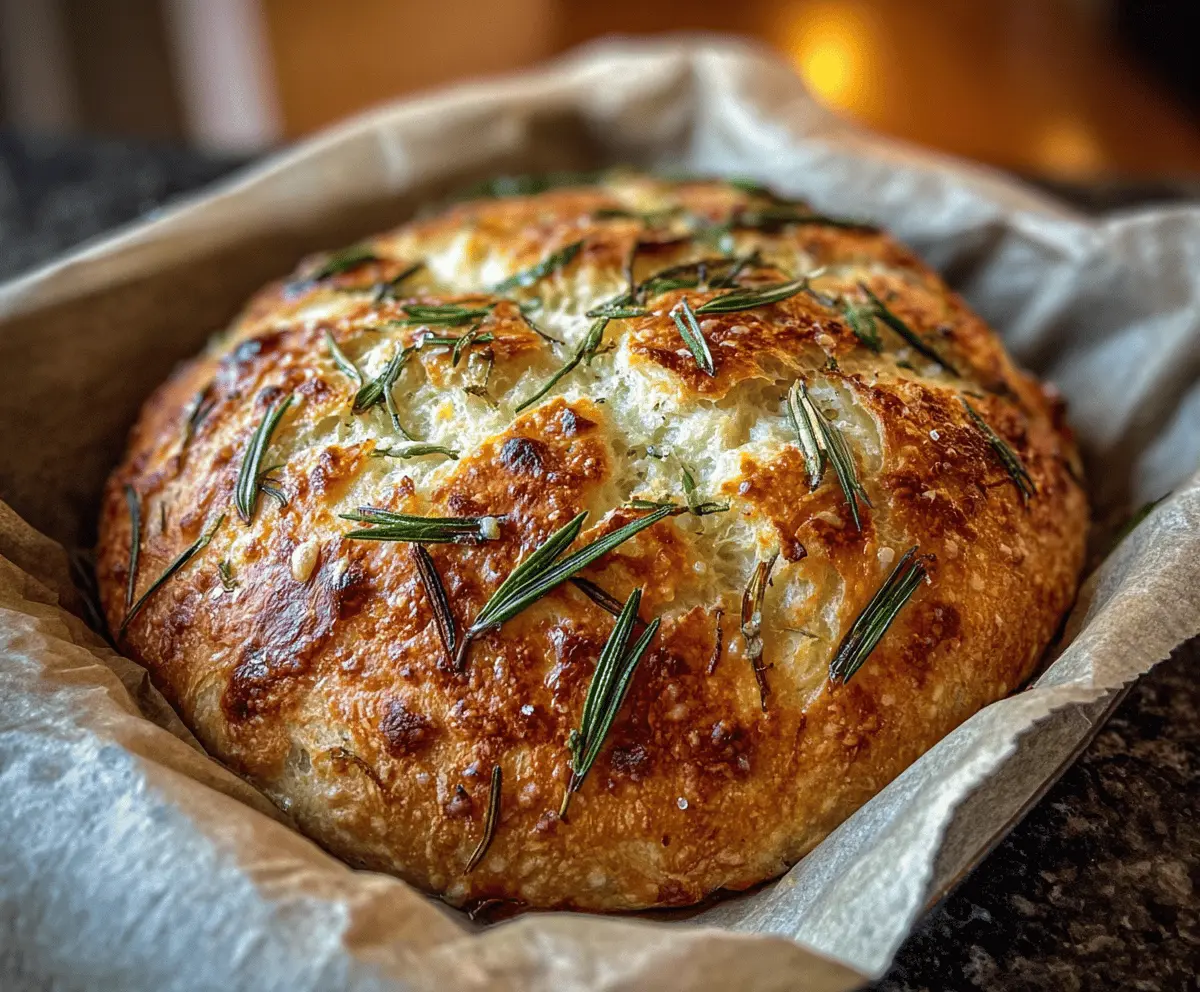
Rustic No-Knead Rosemary Garlic Bread
This Rustic No-Knead Rosemary Garlic Bread is the perfect blend of crispy crust and soft, fluffy inside. With fragrant rosemary and garlic baked right into the dough, every bite bursts…
Tip: save now, cook later.This Rustic No-Knead Rosemary Garlic Bread is the perfect blend of crispy crust and soft, fluffy inside. With fragrant rosemary and garlic baked right into the dough, every bite bursts with flavor without any fuss. The best part is you don’t need to knead the dough, making it an easy way to bring homemade bread to your table.
I love making this bread on a lazy afternoon when I want something fresh and warm without spending too much time in the kitchen. The rosemary and garlic fill the whole house with a cozy scent that always makes me feel like I’m in a little bakery. Plus, it’s so fun to see how the dough slowly rises overnight with just a little waiting.
My favorite way to eat this bread is sliced warm with a bit of butter or dipped into olive oil and balsamic vinegar. It’s great alongside soups or salads, but honestly, it’s so tasty on its own that it usually disappears fast! If you’re new to bread baking, this no-knead recipe is such a friendly place to start and a reliable crowd-pleaser every time.
Key Ingredients & Substitutions
Flour: All-purpose flour works well for this bread, giving a nice structure. If you want a chewier bite, try bread flour instead. Whole wheat flour can add a nuttier flavor but use half to keep the dough light.
Yeast: Instant dry yeast is best because it mixes easily with the flour. If you only have active dry yeast, dissolve it in warm water first before mixing it in.
Rosemary and Garlic: Fresh rosemary and garlic give the best aroma and taste. You can substitute dried rosemary if needed but use less as it’s more concentrated. Garlic powder can replace fresh but won’t have the same punch.
Olive Oil: Olive oil adds moisture and flavor. You could use another mild vegetable oil if necessary, but extra virgin olive oil adds the best taste.
How Can I Make No-Knead Bread Without Kneading?
This bread relies on a long, slow rise rather than kneading to develop gluten and texture. Here’s how to do it well:
- Mix ingredients until just combined—don’t overmix.
- Cover and let the dough rise at room temperature for 12-18 hours. This slow fermentation helps flavor and texture.
- Handle the dough gently after rising to keep air bubbles inside.
- Shape the dough with floured hands and avoid pressing it down.
- Use a hot, lidded Dutch oven or heavy pot to create steam. This gives your bread a crispy crust.
- Bake first with the lid on, then uncovered to brown the crust.
Patience is key! The long rise is what makes this bread so good without any kneading.
Equipment You’ll Need
- Large mixing bowl – perfect for combining ingredients and letting the dough rise without spilling.
- Wooden spoon or spatula – helps mix the sticky dough gently without overworking it.
- Parchment paper – stops the dough from sticking and makes transferring to the hot pot easy.
- Dutch oven or heavy lidded pot – creates steam for a crispy crust and keeps heat even.
- Kitchen towel or plastic wrap – covers the dough to keep it from drying out during rising.
- Wire rack – lets the bread cool properly so the crust stays crisp.
Flavor Variations & Add-Ins
- Add grated Parmesan cheese to the dough for a rich, cheesy twist that pairs well with rosemary.
- Mix in sun-dried tomatoes for a tangy, chewy texture that brightens the bread.
- Swap rosemary for fresh thyme or oregano for a different herbal aroma and taste.
- Stir in chopped olives to add a salty, briny flavor that works great with garlic and herbs.

Rustic No-Knead Rosemary Garlic Bread
Ingredients You’ll Need:
For The Bread:
- 3 cups all-purpose flour (plus extra for dusting)
- 1/4 teaspoon instant dry yeast
- 1 1/4 teaspoons salt
- 1 1/2 cups warm water (about 110°F / 43°C)
- 3 cloves garlic, finely minced or grated
- 2 tablespoons fresh rosemary leaves, chopped (plus extra for topping)
- 2 tablespoons olive oil (plus extra for drizzling)
- Coarse sea salt for sprinkling on top
How Much Time Will You Need?
You’ll need about 15 minutes of active preparation time, mostly mixing and shaping the dough. The dough then needs a long, restful rise of 12 to 18 hours to develop flavor and structure. Baking takes about 45 minutes total, and another 30 minutes to cool before slicing. Plan ahead to enjoy fresh homemade bread!
Step-by-Step Instructions:
1. Mixing The Dough:
In a large bowl, whisk together the flour, yeast, and salt. Add the warm water, olive oil, minced garlic, and chopped rosemary. Stir well with a wooden spoon until everything is combined into a sticky, shaggy dough. Cover the bowl with plastic wrap or a kitchen towel.
2. Letting It Rise:
Leave the dough to rise at room temperature for 12 to 18 hours. Look for bubbles on the surface and a doubled size – this slow fermentation is key to flavor and texture.
3. Shaping The Bread:
Lightly flour a clean surface and gently turn the dough out onto it. Fold the dough over itself once or twice with floured hands to shape it into a ball. Place the dough seam-side down on parchment paper. Cover loosely with a kitchen towel and let it rest for 30 to 45 minutes until puffy.
4. Preparing To Bake:
Meanwhile, preheat your oven to 450°F (230°C) and place a heavy lidded pot (like a Dutch oven) inside to heat for at least 30 minutes.
5. Baking The Bread:
Carefully remove the hot pot from the oven. Using the parchment paper, lift the dough and place it inside the pot. Brush the dough top lightly with olive oil. Sprinkle extra rosemary and a pinch of coarse sea salt on top. Cover with the lid and bake for 30 minutes. Then remove the lid and bake for an additional 15 minutes to brown the crust.
6. Cooling And Serving:
Take the bread out of the oven and transfer it to a wire rack. Let it cool for at least 30 minutes before slicing to allow the crumb to set. Enjoy warm or at room temperature with your favorite toppings or alongside soups and salads!
Can I Use Active Dry Yeast Instead of Instant Yeast?
Yes! If using active dry yeast, dissolve it in the warm water first and let it sit for about 5-10 minutes until foamy before mixing with the dry ingredients.
Can I Make the Dough Ahead of Time?
Absolutely! After mixing, you can refrigerate the dough for up to 24 hours. Just take it out and let it come to room temperature before proceeding with shaping and baking.
How Should I Store Leftover Bread?
Store leftover bread in a paper bag or bread box at room temperature for up to 2 days to keep the crust crisp. For longer storage, wrap tightly and freeze, then thaw at room temperature before reheating.
What Can I Substitute for Fresh Rosemary?
If you don’t have fresh rosemary, dried rosemary works too—use about one-third of the amount since it’s more concentrated. You can also experiment with other herbs like thyme or oregano for a different flavor.

